Submitted:
20 September 2024
Posted:
23 September 2024
You are already at the latest version
Abstract

Keywords:
1. Introduction
2. Study Area and Data
2.1. Study Area
2.2. IMERG Precipitation Data
2.3. NOAA Station Data
3. Methods
3.1. Computing Annual Maximum Series (AMS) from IMERG Data
3.2. Calculating Rainfall Anomaly Index from both IMERG and NOAA Datasets
3.3. Evaluation Metrics
4. Results and Discussions
4.1. Comparing Time Variability between IMERG and NOAA Station RAI Index
4.2. Relationship between Rainfall Anomaly and Maximum Depth
4.3. Regional Attribution of IMERG Precipitation Anomalies
4.3.1. IMERG RAI Index Assessment in Nevada (Dry western CONUS)
4.3.2. Evaluation of IMERG RAI Index in the High-Rainfall Region of Louisiana
4.4. Spatial Evaluation and Hydrological Utility of IMERG RAI Index
4.5. Trend in Rainfall Anomaly in CONUS and Climate Change Implications
4.6. IMERG Precipitation Extractor (IPE) and Uncertainties in IMERG Data
4.6.1. IMERG Precipitation Extractor (IPE): History, Potentials, and Use Cases
4.6.2. Possibilities, Limitations, and Uncertainties in IMERG Data
5. Summary and Conclusions
- (1)
- The IPE web application proves to be an effective tool for rapid precipitation data extraction, visualization, and download at multiple durations globally. It offers functionality for tracking and downloading storm signatures and calculating and downloading anomaly data for specific areas of interest.
- (2)
- The IMERG RAI index demonstrates strong agreement with the NOAA station RAI index. Analysis of data from 2,360 stations reveals an average correlation coefficient (CC) of 0.94, a percent residual bias (PRB) of -22.32%, a root mean square error (RMSE) of 0.96, a mean bias ratio (MBR) of 0.74, a Nash-Sutcliffe efficiency (NSE) of 0.80, and a Kling-Gupta efficiency (KGE) of 0.52. Furthermore, the IMERG RAI index shows a positive correlation with daily annual maximum precipitation depths, with an average CC of 0.42 across the years.
- (3)
- Regional assessments indicate that the IMERG RAI index shows an average CC of 0.95, PRB of 20.71%, RMSE of 0.91, MBR of 0.82, NSE of 0.83, and KGE of 0.29 in the arid western CONUS (Nevada). In contrast, in Louisiana, the wettest state, the statistics are similar with a mean CC of 0.93, PRB of 24.82%, RMSE of 0.96, MBR of 0.79, NSE of 0.80, and KGE of 0.18.
- (4)
- Across CONUS, from west to east, the IMERG RAI index shows good agreement with the station RAI index. Additionally, median RAI indices from both IMERG and NOAA reveal increasing rainfall intensity and frequency since 2010, highlighting climate change issues that have garnered attention in recent years.
Acknowledgments
References
- Gil-Alana, L.A.; Gupta, R.; Sauci, L.; Carmona-González, N. Temperature and Precipitation in the US States: Long Memory, Persistence, and Time Trend. Theor Appl Climatol 2022, 150, 1731–1744. [Google Scholar] [CrossRef] [PubMed]
- Huang, H.; Patricola, C.M.; Winter, J.M.; Osterberg, E.C.; Mankin, J.S. Rise in Northeast US Extreme Precipitation Caused by Atlantic Variability and Climate Change. Weather and Climate Extremes 2021, 33, 100351. [Google Scholar] [CrossRef]
- Adeel, Z.; Bakkensen, L.; Cabrera-Rivera, O.; Franco, E.; Garfin, G.M.; McPherson, R.A.; Méndez, K.; Wen, X. Challenges in and Opportunities for International Collaboration: Costing Flood Damages and Losses across Canada, Mexico, and the United States. 2023. [Google Scholar] [CrossRef]
- Ahn, J.; Cho, W.; Kim, T.; Shin, H.; Heo, J.-H. Flood Frequency Analysis for the Annual Peak Flows Simulated by an Event-Based Rainfall-Runoff Model in an Urban Drainage Basin. Water 2014, 6, 3841–3863. [Google Scholar] [CrossRef]
- Bathrellos, G.D.; Karymbalis, E.; Skilodimou, H.D.; Gaki-Papanastassiou, K.; Baltas, E.A. Urban Flood Hazard Assessment in the Basin of Athens Metropolitan City, Greece. Environ Earth Sci 2016, 75, 319. [Google Scholar] [CrossRef]
- Corringham, T.W.; McCarthy, J.; Shulgina, T.; Gershunov, A.; Cayan, D.R.; Ralph, F.M. Climate Change Contributions to Future Atmospheric River Flood Damages in the Western United States. Sci Rep 2022, 12, 13747. [Google Scholar] [CrossRef]
- Devitt, L.; Neal, J.; Wagener, T.; Coxon, G. Uncertainty in the Extreme Flood Magnitude Estimates of Large-Scale Flood Hazard Models. Environ. Res. Lett. 2021, 16, 064013. [Google Scholar] [CrossRef]
- Gabriels, K.; Willems, P.; Van Orshoven, J. A Comparative Flood Damage and Risk Impact Assessment of Land Use Changes. Natural Hazards and Earth System Sciences 2022, 22, 395–410. [Google Scholar] [CrossRef]
- Quinn, N.; Bates, P.D.; Neal, J.; Smith, A.; Wing, O.; Sampson, C.; Smith, J.; Heffernan, J. The Spatial Dependence of Flood Hazard and Risk in the United States. Water Resources Research 2019, 55, 1890–1911. [Google Scholar] [CrossRef]
- Ekpetere, K.; Ekeh, F.; Ofodum, N. Impact of Abattoir Wastes on Groundwater Quality in the Fct, Abuja-Nigeria: A Case Study of Gwagwalada Satellite Town. 2019, 9, 90. [Google Scholar] [CrossRef]
- Armal, S.; Khanbilvardi, R. Anomalies in the US Precipitation Extremes and Their Association with Different Modes of Climate Variability. Hydrological Sciences Journal 2019, 64, 1605–1615. [Google Scholar] [CrossRef]
- Córdova, M.; Célleri, R.; van Delden, A. Dynamics of Precipitation Anomalies in Tropical South America. Atmosphere 2022, 13, 972. [Google Scholar] [CrossRef]
- Baratto, J.; de Bodas Terassi, P.M.; de Beserra de Lima, N.G.; Galvani, E. Precipitation Anomalies and Trends Estimated via Satellite Rainfall Products in the Cananeia–Iguape Coastal System, Southeast Region of Brazil. Climate 2024, 12, 22. [Google Scholar] [CrossRef]
- Xu, Y.; Zhao, Y.; Wu, Y.; Gao, C. Change Patterns of Precipitation Anomalies and Possible Teleconnections with Large-Scale Climate Oscillations over the Yangtze River Delta, China. Journal of Water and Climate Change 2022, 13, 2972–2990. [Google Scholar] [CrossRef]
- Yu, L.; Zhong, S.; Pei, L.; Bian, X.; Heilman, W.E. Contribution of Large-Scale Circulation Anomalies to Changes in Extreme Precipitation Frequency in the United States. Environ. Res. Lett. 2016, 11, 044003. [Google Scholar] [CrossRef]
- Singh, J.; Karmakar, S.; PaiMazumder, D.; Ghosh, S.; Niyogi, D. Urbanization Alters Rainfall Extremes over the Contiguous United States. Environ. Res. Lett. 2020, 15, 074033. [Google Scholar] [CrossRef]
- Bonnin; Martin; Lin; Parzybok; Yekta; Riley Precipitation-Frequency Atlas of the United States. 2006.
- Miller; Frederick; Tracey Precipitation-Frequency Atlas of the Western United States. 1973.
- NOAA NOAA Atlas 14 Time Series Data of Annual Maximum Precipitation. 2017.
- Perica, S.; Lin, B.; Martin, D.; Martin, F.; Brewer, D.; Trypaluk, C.; Yekta, M.; Hiner, L.; Heim, S.; Dietz, S.; et al. NOAA Atlas 14 Precipitation-Frequency Atlas of the United States. 2011, 5. [Google Scholar]
- NOAA-OWP NOAA ATLAS 15: Update to the National Precipitation Frequency Standard 2022.
- Perica, S.; Martin, D.; Pavlovic, S.; Roy, I.; St. Laurent, M.; Trypaluk, C.; Unruh, D.; Yekta, M.; Bonnin, G. Precipitation-Frequency Atlas of the United States 2013.
- Palmer, W. Meteorological Drought. Research Paper No. 45, 1965, 58 p. 2006, 1–65.
- Vicente-Serrano, S.M.; Beguería, S.; López-Moreno, J.I. A Multiscalar Drought Index Sensitive to Global Warming: The Standardized Precipitation Evapotranspiration Index. 2010. [Google Scholar] [CrossRef]
- Mckee, T.; Doesken, N.; Kleist, J. The Relationship of Drought Frequency and Duration to Time Scales. 1993. [Google Scholar]
- Raziei, T. Revisiting the Rainfall Anomaly Index to Serve as a Simplified Standardized Precipitation Index. Journal of Hydrology 2021, 602, 126761. [Google Scholar] [CrossRef]
- Van-rooy, M.P. A Rainfall Anomaly Index (RAI), Independent of the Time and Space, 1965.
- Costa, J.; Rodrigues, G. Space-Time Distribution of Rainfall Anomaly Index (RAI) for the Salgado Basin, Ceará State - Brazil. Ciência e Natura 2017, 39, 627. [Google Scholar] [CrossRef]
- Koudahe, K.; Kayode, A.J.; Samson, A.O.; Adebola, A.A.; Djaman, K. Trend Analysis in Standardized Precipitation Index and Standardized Anomaly Index in the Context of Climate Change in Southern Togo. Atmospheric and Climate Sciences 2017, 7, 401–423. [Google Scholar] [CrossRef]
- Arias, P.A.; Fu, R.; Mo, K.C. Decadal Variation of Rainfall Seasonality in the North American Monsoon Region and Its Potential Causes. Journal of Climate 2012, 25, 4258–4274. [Google Scholar] [CrossRef]
- Gu, L.; Yin, J.; Gentine, P.; Wang, H.-M.; Slater, L.J.; Sullivan, S.C.; Chen, J.; Zscheischler, J.; Guo, S. Large Anomalies in Future Extreme Precipitation Sensitivity Driven by Atmospheric Dynamics. Nat Commun 2023, 14, 3197. [Google Scholar] [CrossRef] [PubMed]
- Lau, A.; Behrangi, A. Understanding Intensity–Duration–Frequency (IDF) Curves Using IMERG Sub-Hourly Precipitation against Dense Gauge Networks. Remote Sensing 2022, 14, 5032. [Google Scholar] [CrossRef]
- Noor, M.; Ismail, T.; Shahid, S.; Asaduzzaman, M.; Dewan, A. Evaluating Intensity-Duration-Frequency (IDF) Curves of Satellite-Based Precipitation Datasets in Peninsular Malaysia. Atmospheric Research 2021, 248, 105203. [Google Scholar] [CrossRef]
- Ekpetere, K. Assessment of the PMPs and Design Storms Estimated from the IMERG Satellite Precipitation Data. Ph.D., University of Kansas: United States -- Kansas, 2024.
- Alamri, N.; Subyani, A. Generation of Rainfall Intensity Duration Frequency (IDF) Curves for Ungauged Sites in Arid Region. Earth Systems and Environment 2017, 1, 8. [Google Scholar] [CrossRef]
- De Paola, F.; Giugni, M.; Topa, M.E.; Bucchignani, E. Intensity-Duration-Frequency (IDF) Rainfall Curves, for Data Series and Climate Projection in African Cities. SpringerPlus 2014, 3, 133. [Google Scholar] [CrossRef] [PubMed]
- Duque-Gardeazabal, N.; Rodríguez, E.A. Improving Rainfall Fields in Data-Scarce Basins: Influence of the Kernel Bandwidth Value of Merging on Hydrometeorological Modeling. Journal of Hydrologic Engineering 2023, 28, 04023017. [Google Scholar] [CrossRef]
- Kim, D.-E.; Gourbesville, P.; Liong, S.-Y. Overcoming Data Scarcity in Flood Hazard Assessment Using Remote Sensing and Artificial Neural Network. Smart Water 2019, 4, 2. [Google Scholar] [CrossRef]
- Tan, M.L.; Yang, X. Effect of Rainfall Station Density, Distribution and Missing Values on SWAT Outputs in Tropical Region. Journal of Hydrology 2020, 584, 124660. [Google Scholar] [CrossRef]
- Willems, P. Stochastic Generation of Spatial Rainfall for Urban Drainage Areas. Water Science and Technology 1999, 39, 23–30. [Google Scholar] [CrossRef]
- Willems, P. Compound Intensity/Duration/Frequency-Relationships of Extreme Precipitation for Two Seasons and Two Storm Types. Journal of Hydrology 2000, 233, 189–205. [Google Scholar] [CrossRef]
- Ekpetere, K.; Abdelkader, M.; Ishaya, S.; Makwe, E.; Ekpetere, P. Integrating Satellite Imagery and Ground-Based Measurements with a Machine Learning Model for Monitoring Lake Dynamics over a Semi-Arid Region. Hydrology 2023, 10, 78. [Google Scholar] [CrossRef]
- Chen, J.; Liao, J.; Lou, Y.; Ma, S.; Shen, G.; Zhang, L. High-Resolution Datasets for Lake Level Changes in the Qinghai-Tibetan Plateau from 2002 to 2021 Using Multi-Altimeter Data. Earth System Science Data Discussions 2022, 1–18. [Google Scholar] [CrossRef]
- Gu, H.; Ma, Z.; Li, M. Effect of a Large and Very Shallow Lake on Local Summer Precipitation over the Lake Taihu Basin in China. Journal of Geophysical Research: Atmospheres 2016, 121, 8832–8848. [Google Scholar] [CrossRef]
- Pradhan, R.K.; Markonis, Y.; Vargas Godoy, M.R.; Villalba-Pradas, A.; Andreadis, K.M.; Nikolopoulos, E.I.; Papalexiou, S.M.; Rahim, A.; Tapiador, F.J.; Hanel, M. Review of GPM IMERG Performance: A Global Perspective. Remote Sensing of Environment 2022, 268, 112754. [Google Scholar] [CrossRef]
- Schamm, K.; Ziese, M.; Becker, A.; Finger, P.; Meyer-Christoffer, A.; Schneider, U.; Schröder, M.; Stender, P. Global Gridded Precipitation over Land: A Description of the New GPCC First Guess Daily Product. Earth System Science Data 2014, 6, 49–60. [Google Scholar] [CrossRef]
- Zhao, G.; Li, Y.; Zhou, L.; Gao, H. Evaporative Water Loss of 1.42 Million Global Lakes. Nat Commun 2022, 13, 3686. [Google Scholar] [CrossRef]
- Kasi, V.; Rathinasamy, M.; Jarajapu, D. Framework for Developing IDF Curves Using Satellite Precipitation: A Case Study Using GPM-IMERG V6 Data. Earth Science Informatics 2022, 15, 1–17. [Google Scholar] [CrossRef]
- Mab, P.; Ly, S.; Chompuchan, C.; Kositsakulchai, E. Evaluation of Satellite Precipitation from Google Earth Engine in Tonle Sap Basin, Cambodia, 2019.
- Aksu, H.; Taflan, G.Y.; Yaldiz, S.G.; Akgül, M.A. Evaluation of IMERG for GPM Satellite-Based Precipitation Products for Extreme Precipitation Indices over Turkiye. Atmospheric Research 2023, 291, 106826. [Google Scholar] [CrossRef]
- Huffman Algorithm Theoretical Basis Document (ATBD) Version 06 of NASA Global Precipitation Measurement (GPM) Integrated Multi-satellitE Retrievals for GPM (IMERG) 2020.
- Ning, S.; Song, F.; Udmale, P.; Jin, J.; Thapa, B.R.; Ishidaira, H. Error Analysis and Evaluation of the Latest GSMap and IMERG Precipitation Products over Eastern China. Advances in Meteorology 2017, 2017, e1803492. [Google Scholar] [CrossRef]
- Pucknell, S.; Kjeldsen, T.; Haxton, T.; Jeans, J.; Young, A. Estimating the Probable Maximum Flood in UK Catchments Using the ReFH Model. Dams and Reservoirs 2020, 30, 85–90. [Google Scholar] [CrossRef]
- Anjum, M.N.; Ding, Y.; Shangguan, D.; Ahmad, I.; Ijaz, M.W.; Farid, H.U.; Yagoub, Y.E.; Zaman, M.; Adnan, M. Performance Evaluation of Latest Integrated Multi-Satellite Retrievals for Global Precipitation Measurement (IMERG) over the Northern Highlands of Pakistan. Atmospheric Research 2018, 205, 134–146. [Google Scholar] [CrossRef]
- Dehaghani, A.M.; Gohari, A.; Zareian, M.J.; Torabi Haghighi, A. A Comprehensive Evaluation of the Satellite Precipitation Products across Iran. Journal of Hydrology: Regional Studies 2023, 46, 101360. [Google Scholar] [CrossRef]
- Min Yang; Zhongqin Li; Muhammad Naveed Anjum; Yayu Gao Performance Evaluation of Version 5 (V05) of Integrated Multi-Satellite Retrievals for Global Precipitation Measurement (IMERG) over the Tianshan Mountains of China. Water 2019, 11, 1139. [CrossRef]
- Wang, J.; Petersen, W.A.; Wolff, D.B. Validation of Satellite-Based Precipitation Products from TRMM to GPM. Remote Sensing 2021, 13, 1745. [Google Scholar] [CrossRef]
- Wang, Y.; Miao, C.; Zhao, X.; Zhang, Q.; Su, J. Evaluation of the GPM IMERG Product at the Hourly Timescale over China. Atmospheric Research 2023, 285, 106656. [Google Scholar] [CrossRef]
- Weng, P.; Tian, Y.; Jiang, Y.; Chen, D.; Kang, J. Assessment of GPM IMERG and GSMaP Daily Precipitation Products and Their Utility in Droughts and Floods Monitoring across Xijiang River Basin. Atmospheric Research 2023, 286, 106673. [Google Scholar] [CrossRef]
- Yuan, F.; Wang, B.; Shi, C.; Cui, W.; Zhao, C.; Liu, Y.; Ren, L.; Zhang, L.; Zhu, Y.; Chen, T.; et al. Evaluation of Hydrological Utility of IMERG Final Run V05 and TMPA 3B42V7 Satellite Precipitation Products in the Yellow River Source Region, China. Journal of Hydrology 2018, 567, 696–711. [Google Scholar] [CrossRef]
- Zhao, H.; Yang, B.; Yang, S.; Huang, Y.; Dong, G.; Bai, J.; Wang, Z. Systematical Estimation of GPM-Based Global Satellite Mapping of Precipitation Products over China. Atmospheric Research 2018, 201, 206–217. [Google Scholar] [CrossRef]
- Zhou, Z.; Lu, D.; Yong, B.; Shen, Z.; Wu, H.; Yu, L. Evaluation of GPM-IMERG Precipitation Product at Multiple Spatial and Sub-Daily Temporal Scales over Mainland China. Remote Sensing 2023, 15, 1237. [Google Scholar] [CrossRef]
- Peinó, E.; Bech, J.; Udina, M. Dependence of GPM IMERG Products on Precipitation Intensity in Catalonia; Copernicus Meetings, 2023. [Google Scholar]
- Sathianarayanan, M.; Hsu, P.-H. SPATIAL DOWNSCALING OF GPM IMERG V06 GRIDDED PRECIPITATION USING MACHINE LEARNING ALGORITHMS. Int. Arch. Photogramm. Remote Sens. Spatial Inf. Sci. 2023, XLVIII-4/W6-2022, 327–332. [Google Scholar] [CrossRef]
- Tang, S.; Li, R.; He, J.; Wang, H.; Fan, X.; Yao, S. Comparative Evaluation of the GPM IMERG Early, Late, and Final Hourly Precipitation Products Using the CMPA Data over Sichuan Basin of China. Available online: https://doaj.org (accessed on 12 February 2021).
- Xin, Y.; Yang, Y.; Chen, X.; Yue, X.; Liu, Y.; Yin, C. Evaluation of IMERG and ERA5 Precipitation Products over the Mongolian Plateau. Sci Rep 2022, 12, 21776. [Google Scholar] [CrossRef] [PubMed]
- Nasta, P.; Allocca, C.; Deidda, R.; Romano, N. Assessing the Impact of Seasonal-Rainfall Anomalies on Catchment-Scale Water Balance Components. Hydrology and Earth System Sciences 2020, 24, 3211–3227. [Google Scholar] [CrossRef]
- Henny, L.; Thorncroft, C.D.; Bosart, L.F. Changes in Seasonal Large-Scale Extreme Precipitation in the Mid-Atlantic and Northeast United States, 1979–2019. 2023. [Google Scholar] [CrossRef]
- Le, P.V.V.; Randerson, J.T.; Willett, R.; Wright, S.; Smyth, P.; Guilloteau, C.; Mamalakis, A.; Foufoula-Georgiou, E. Climate-Driven Changes in the Predictability of Seasonal Precipitation. Nat Commun 2023, 14, 3822. [Google Scholar] [CrossRef]
- Da Silva, N.A.; Webber, B.G.M.; Matthews, A.J.; Feist, M.M.; Stein, T.H.M.; Holloway, C.E.; Abdullah, M.F.A.B. Validation of GPM IMERG Extreme Precipitation in the Maritime Continent by Station and Radar Data. Earth and Space Science 2021, 8, e2021EA001738. [Google Scholar] [CrossRef]
- Tan, M.L.; Santo, H. Comparison of GPM IMERG, TMPA 3B42 and PERSIANN-CDR Satellite Precipitation Products over Malaysia. Atmospheric Research 2018, 202, 63–76. [Google Scholar] [CrossRef]
- NWS, N. HDSC PMP Documents. Available online: https://www.weather.gov/owp/hdsc_pmp (accessed on 22 June 2022).
- NOAA; National Ocean Service; National Geodetic Survey NOAA Guidance Document for Determination of Vertical Land Motion at Water Level Stations Using GPS Technology 2015.
- Huffman; Bolvin, D.T.; Nelkin, E.J.; Wolff, D.B.; Adler, R.F.; Gu, G.; Hong, Y.; Bowman, K.P.; Stocker, E.F. The TRMM Multisatellite Precipitation Analysis (TMPA): Quasi-Global, Multiyear, Combined-Sensor Precipitation Estimates at Fine Scales. Journal of Hydrometeorology 2007, 8, 38–55. [Google Scholar] [CrossRef]
- Dekai Lu; Bin Yong Evaluation and Hydrological Utility of the Latest GPM IMERG V5 and GSMaP V7 Precipitation Products over the Tibetan Plateau. Remote Sensing 2018, 10, 2022. [CrossRef]
- Gebregiorgis, A.S.; Kirstetter, P.-E.; Hong, Y.E.; Gourley, J.J.; Huffman, G.J.; Petersen, W.A.; Xue, X.; Schwaller, M.R. To What Extent Is the Day 1 GPM IMERG Satellite Precipitation Estimate Improved as Compared to TRMM TMPA-RT? Journal of Geophysical Research: Atmospheres 2018, 123, 1694–1707. [Google Scholar] [CrossRef]
- Gao, P.; Carbone, G.J.; Lu, J.; Guo, D. An Area-Based Approach for Estimating Extreme Precipitation Probability. Geographical Analysis 2018, 50, 314–333. [Google Scholar] [CrossRef]
- Wang, S.; Zuo, H.; Yin, Y.; Hu, C.; Yin, J.; Ma, X.; Wang, J. Interpreting Rainfall Anomalies Using Rainfall’s Nonnegative Nature. Geophysical Research Letters 2019, 46, 426–434. [Google Scholar] [CrossRef]
- Guo, B.; Xu, T.; Yang, Q.; Zhang, J.; Dai, Z.; Deng, Y.; Zou, J. Multiple Spatial and Temporal Scales Evaluation of Eight Satellite Precipitation Products in a Mountainous Catchment of South China. Remote Sensing 2023, 15, 1373. [Google Scholar] [CrossRef]
- Guo; Chen, S.; Bao, A.; Behrangi, A.; Hong, Y.; Ndayisaba, F.; Hu, J.; Stepanian, P.M. Early Assessment of Integrated Multi-Satellite Retrievals for Global Precipitation Measurement over China. Atmospheric Research 2016, 176–177, 121–133. [Google Scholar] [CrossRef]
- Huff, F.A. Time Distribution of Rainfall in Heavy Storms. Water Resources Research 1967, 3, 1007–1019. [Google Scholar] [CrossRef]
- Stavish, M. Using Standard Anomaly and Ensemble Data to Support Forecast Confidence of an Extreme Wind Event in the Pacific Northwest on December 14th-15th 2006. 2007. [Google Scholar]
- Zaveri, E.; Russ, J.; Damania, R. Rainfall Anomalies Are a Significant Driver of Cropland Expansion. Proceedings of the National Academy of Sciences 2020, 117, 10225–10233. [Google Scholar] [CrossRef]
- LaRocque, A. Probable Maximum Flood (PMF). In Encyclopedia of Natural Hazards; Bobrowsky, P.T., Ed.; Springer Netherlands: Dordrecht, 2013; pp. 777–778. ISBN 978-1-4020-4399-4. [Google Scholar]
- VDCR Probable Maximum Precipitation Study and Evaluation Tool (Virginia Department of Conservation and Recreation). Available online: https://www.dcr.virginia.gov/dam-safety-and-floodplains/pmp-tool (accessed on 1 November 2021).
- Zischg, A.P.; Felder, G.; Weingartner, R.; Quinn, N.; Coxon, G.; Neal, J.; Freer, J.; Bates, P. Effects of Variability in Probable Maximum Precipitation Patterns on Flood Losses. Hydrology and Earth System Sciences 2018, 22, 2759–2773. [Google Scholar] [CrossRef]
- Boota, M.W.; Nabi, G.; Abbas, T.; Yaseen, M.; Faisal, M.; Azam, M.I. ESTIMATION OF PROBABLE MAXIMUM FLOOD (PMF): A CASE STUDY OF POTHWAR REGION, PAKISTAN. 2015, 5. [Google Scholar]
- Fashae, O.; Jolaade, O.; OLUSOLA, A. An Assessment of Digital Elevation Model for Geospatial Studies: A Case Study of Alawa Town, Niger State, Nigeria. Ife Research Publications in Geography 2017, 15, 31–51. [Google Scholar]
- Trinh, T.; Diaz, A.; Iseri, Y.; Snider, E.; Anderson, M.L.; Carr, K.J.; Kavvas, M.L. A Numerical Coupled Atmospheric–Hydrologic Modeling System for Probable Maximum Flood Estimation with Application to California’s Southern Sierra Nevada Foothills Watersheds. Journal of Flood Risk Management 2022, n/a, e12809. [Google Scholar] [CrossRef]
- Pan, L.-L.; Chen, S.-H.; Cayan, D.; Lin, M.-Y.; Hart, Q.; Zhang, M.-H.; Liu, Y.; Wang, J. Influences of Climate Change on California and Nevada Regions Revealed by a High-Resolution Dynamical Downscaling Study. Clim Dyn 2011, 37, 2005–2020. [Google Scholar] [CrossRef]
- Yu, Z.; Jiang, P.; Gautam, M.R.; Zhang, Y.; Acharya, K. Changes of Seasonal Storm Properties in California and Nevada from an Ensemble of Climate Projections. Journal of Geophysical Research: Atmospheres 2015, 120, 2676–2688. [Google Scholar] [CrossRef]
- Hoell, A.; Quan, X.-W.; Hoerling, M.; Diaz, H.F.; Fu, R.; He, C.; Lisonbee, J.R.; Mankin, J.S.; Seager, R.; Sheffield, A.; et al. Water Year 2021 Compound Precipitation and Temperature Extremes in California and Nevada. Bulletin of the American Meteorological Society 2022, 103, E2905–E2911. [Google Scholar] [CrossRef]
- Byrne, S.M.; Merrifield, M.A.; Carter, M.L.; Cayan, D.R.; Flick, R.E.; Gershunov, A.; Giddings, S.N. Southern California Winter Precipitation Variability Reflected in 100-Year Ocean Salinity Record. Commun Earth Environ 2023, 4, 1–9. [Google Scholar] [CrossRef]
- Hoell, A.; Quan, X.-W.; Hoerling, M.; Diaz, H.F.; Fu, R.; He, C.; Lisonbee, J.R.; Mankin, J.S.; Seager, R.; Sheffield, A.; et al. Water Year 2021 Compound Precipitation and Temperature Extremes in California and Nevada. 2022. [Google Scholar] [CrossRef]
- Hu, F.; Zhang, L.; Liu, Q.; Chyi, D. Environmental Factors Controlling the Precipitation in California. Atmosphere 2021, 12, 997. [Google Scholar] [CrossRef]
- Zhang, G.; Su, X.; Singh, V.P.; Ayantobo, O.O. Appraising Standardized Moisture Anomaly Index (SZI) in Drought Projection across China under CMIP6 Forcing Scenarios. Journal of Hydrology: Regional Studies 2021, 37, 100898. [Google Scholar] [CrossRef]
- Gavahi, K.; Abbaszadeh, P.; Moradkhani, H. How Does Precipitation Data Influence the Land Surface Data Assimilation for Drought Monitoring? Science of The Total Environment 2022, 831, 154916. [Google Scholar] [CrossRef] [PubMed]
- Tibbetts, J. Louisiana’s Wetlands: A Lesson in Nature Appreciation. Environ Health Perspect 2006, 114, A40–A43. [Google Scholar] [CrossRef]
- Brown, V.M.; Keim, B.D.; Kappel, W.D.; Hultstrand, D.M.; Peyrefitte, A.G.; Black, A.W.; Steinhilber, K.M.; Muhlestein, G.A. How Rare Was the August 2016 South-Central Louisiana Heavy Rainfall Event? 2020. [Google Scholar] [CrossRef]
- Faiers, G.E.; Grymes, J.M.; Keim, B.D.; Muller, R.A. A Reexamination of Extreme 24-Hour Rainfall in Louisiana, USA. Climate Research 1994, 4, 25–31. [Google Scholar] [CrossRef]
- Ekpetere, K.; Li, X.; Frame, J. Metadata for the Rapid Forcing Retrieval (RFR) Web Tool 2022.
- Felder, G.; Paquet, E.; Penot, D.; Zischg, A.; Weingartner, R. Consistency of Extreme Flood Estimation Approaches. Journal of Hydrologic Engineering 2019, 24, 04019018. [Google Scholar] [CrossRef]
- Yuan, F.; Zhang, L.; Ren, L.; Zhao, C.; Zhu, Y.; Jiang, S.; Liu, Y. Applications of TRMM- and GPM-Era Multiple-Satellite Precipitation Products for Flood Simulations at Sub-Daily Scales in a Sparsely Gauged Watershed in Myanmar. Remote Sensing 2019, 11. [Google Scholar] [CrossRef]
- Gershunov, A.; Shulgina, T.; Clemesha, R.E.S.; Guirguis, K.; Pierce, D.W.; Dettinger, M.D.; Lavers, D.A.; Cayan, D.R.; Polade, S.D.; Kalansky, J.; et al. Precipitation Regime Change in Western North America: The Role of Atmospheric Rivers. Sci Rep 2019, 9, 9944. [Google Scholar] [CrossRef]
- McKitrick, R.; Christy, J. Assessing Changes in US Regional Precipitation on Multiple Time Scales. Journal of Hydrology 2019, 578, 124074. [Google Scholar] [CrossRef]
- Kappel, B. PMP Estimation for Mine Tailings Dams in Data Limited Regions. In Sustainable and Safe Dams Around the World; Tournier, J.-P., Bennett, T., Bibeau, J., Eds.; CRC Press, 2019; pp. 3170–3182. ISBN 978-0-429-31977-8. [Google Scholar]
- Umar, N.; Gray, A. Flooding in Nigeria: A Review of Its Occurrence and Impacts and Approaches to Modelling Flood Data. International Journal of Environmental Studies 2023, 80, 540–561. [Google Scholar] [CrossRef]
- Li, N.; Tang, G.; Zhao, P.; Hong, Y.; Gou, Y.; Yang, K. Statistical Assessment and Hydrological Utility of the Latest Multi-Satellite Precipitation Analysis IMERG in Ganjiang River Basin. Atmospheric Research 2017, 183, 212–223. [Google Scholar] [CrossRef]
- Wu, X.; Su, J.; Ren, W.; Lü, H.; Yuan, F. Statistical Comparison and Hydrological Utility Evaluation of ERA5-Land and IMERG Precipitation Products on the Tibetan Plateau. Journal of Hydrology 2023, 620, 129384. [Google Scholar] [CrossRef]
- Hosseini-Moghari, S.-M.; Tang, Q. Can IMERG Data Capture the Scaling of Precipitation Extremes With Temperature at Different Time Scales? Geophysical Research Letters 2022, 49, e2021GL096392. [Google Scholar] [CrossRef]
- Li, R.; Guilloteau, C.; Kirstetter, P.-E.; Foufoula-Georgiou, E. How Well Does the IMERG Satellite Precipitation Product Capture the Timing of Precipitation Events? Journal of Hydrology 2023, 620, 129563. [Google Scholar] [CrossRef]
- Gabric, O.; Prodanovic, D.; Plavsic, J. Uncertainty Assessment of Rainfall Simulator Uniformity Coefficient.; April 24 2014.
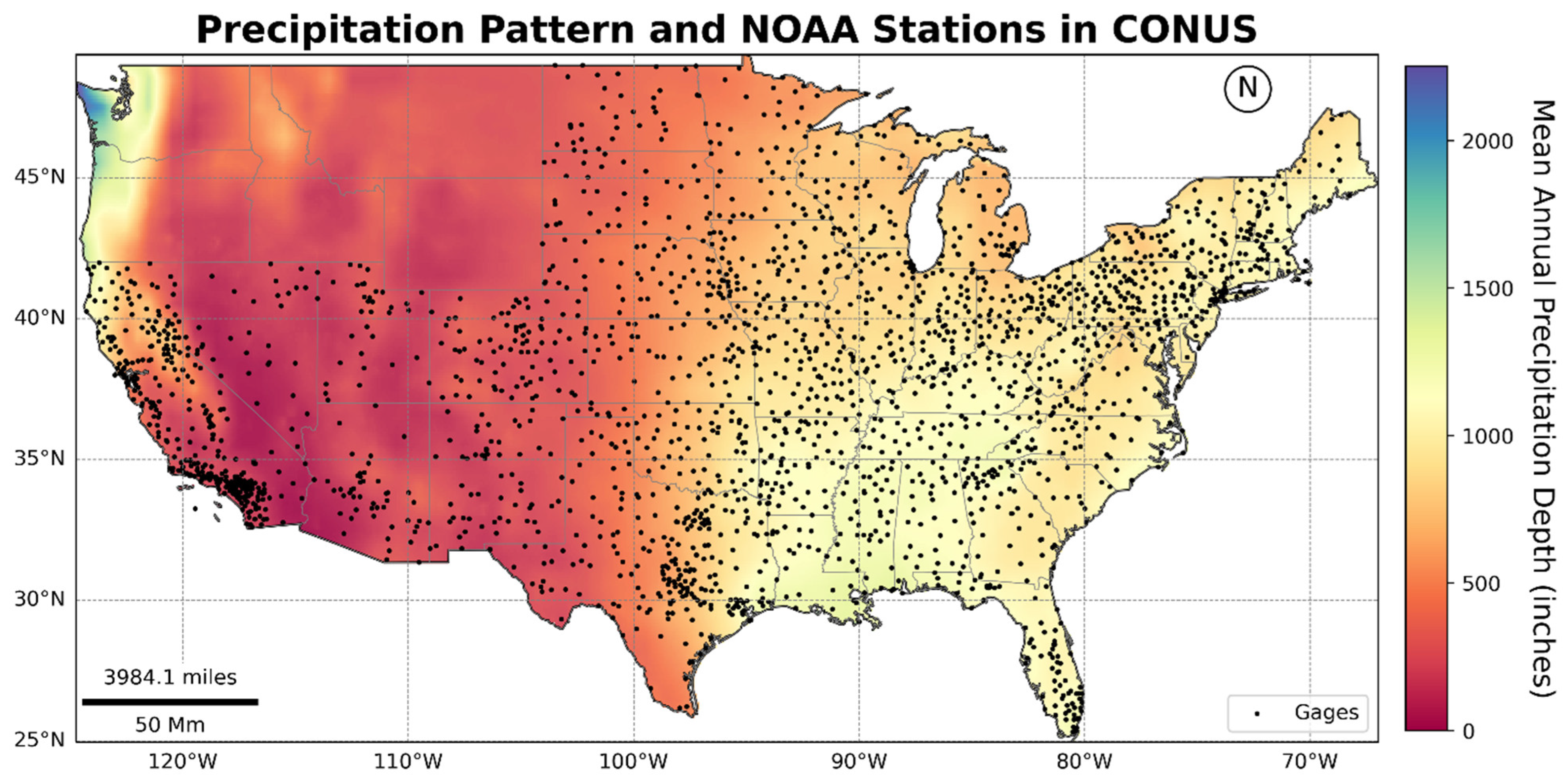
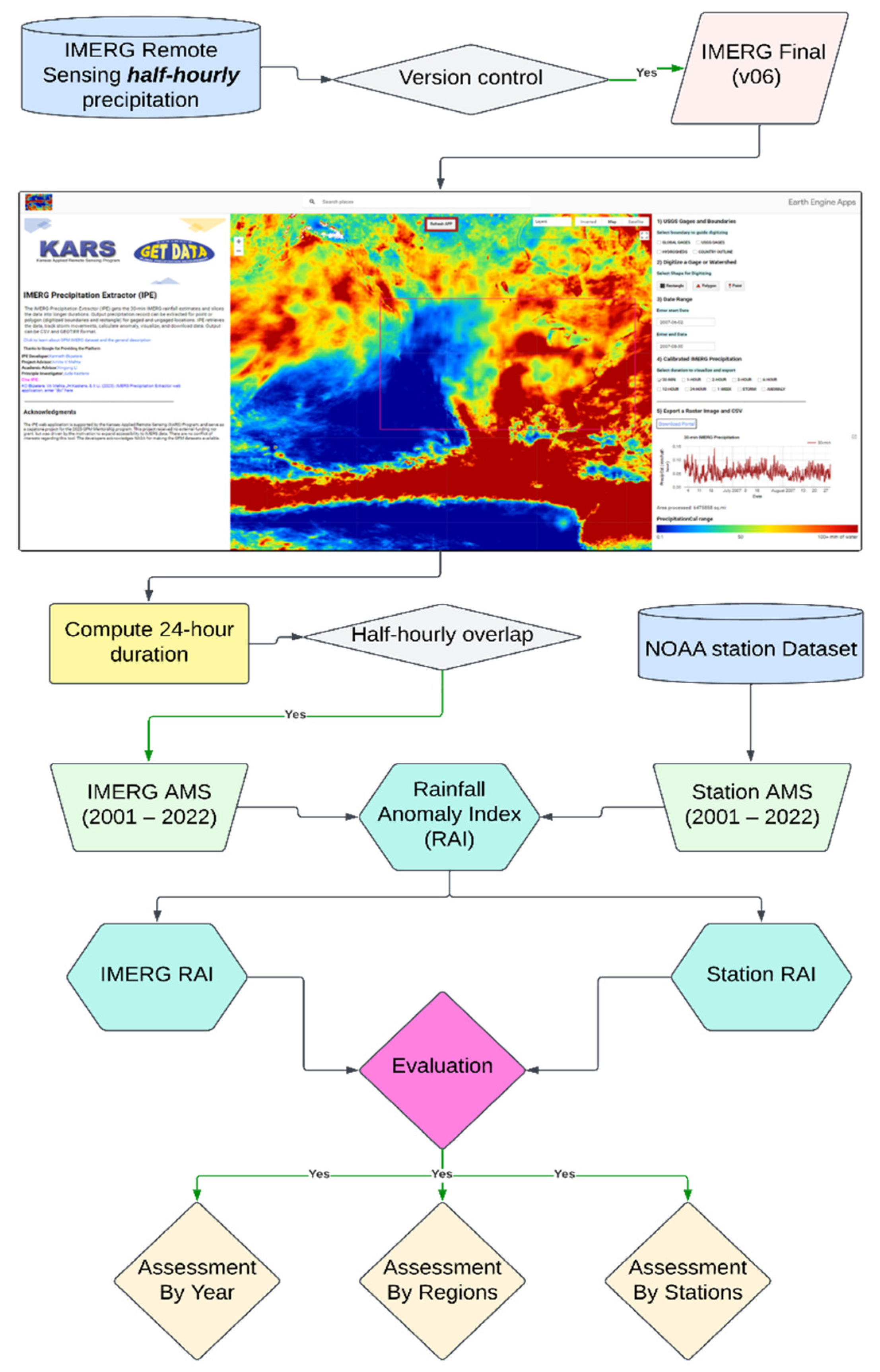
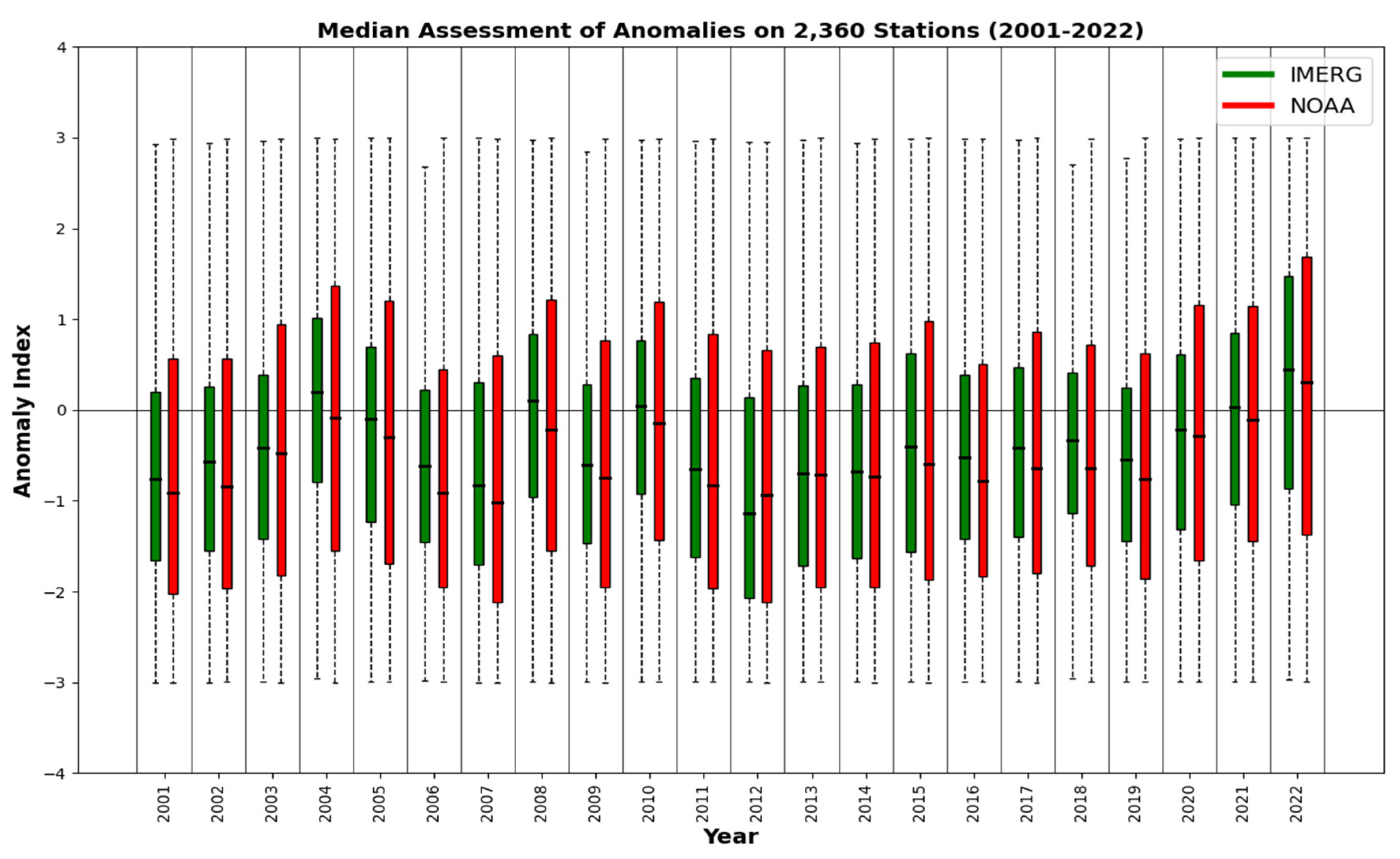
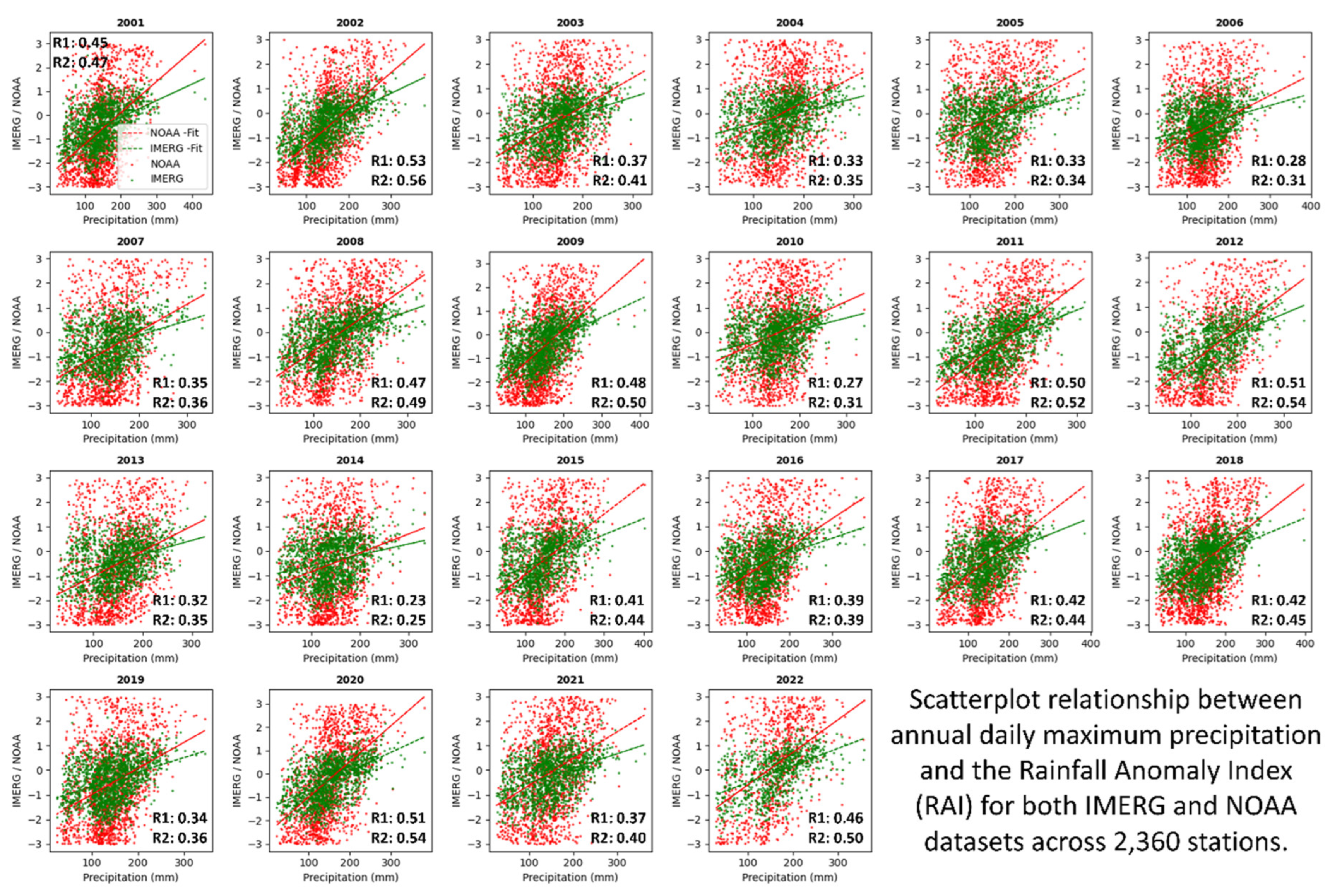
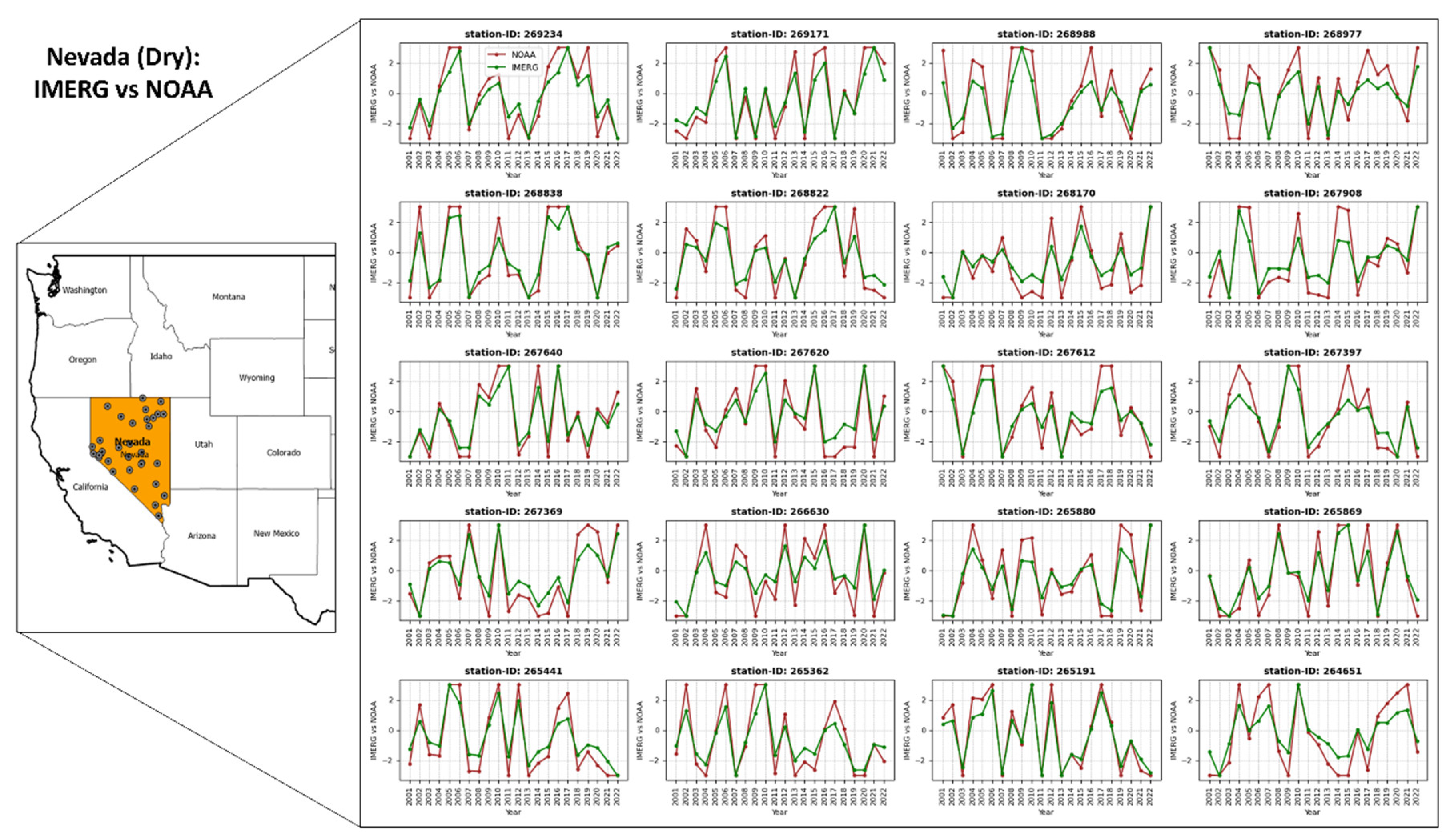
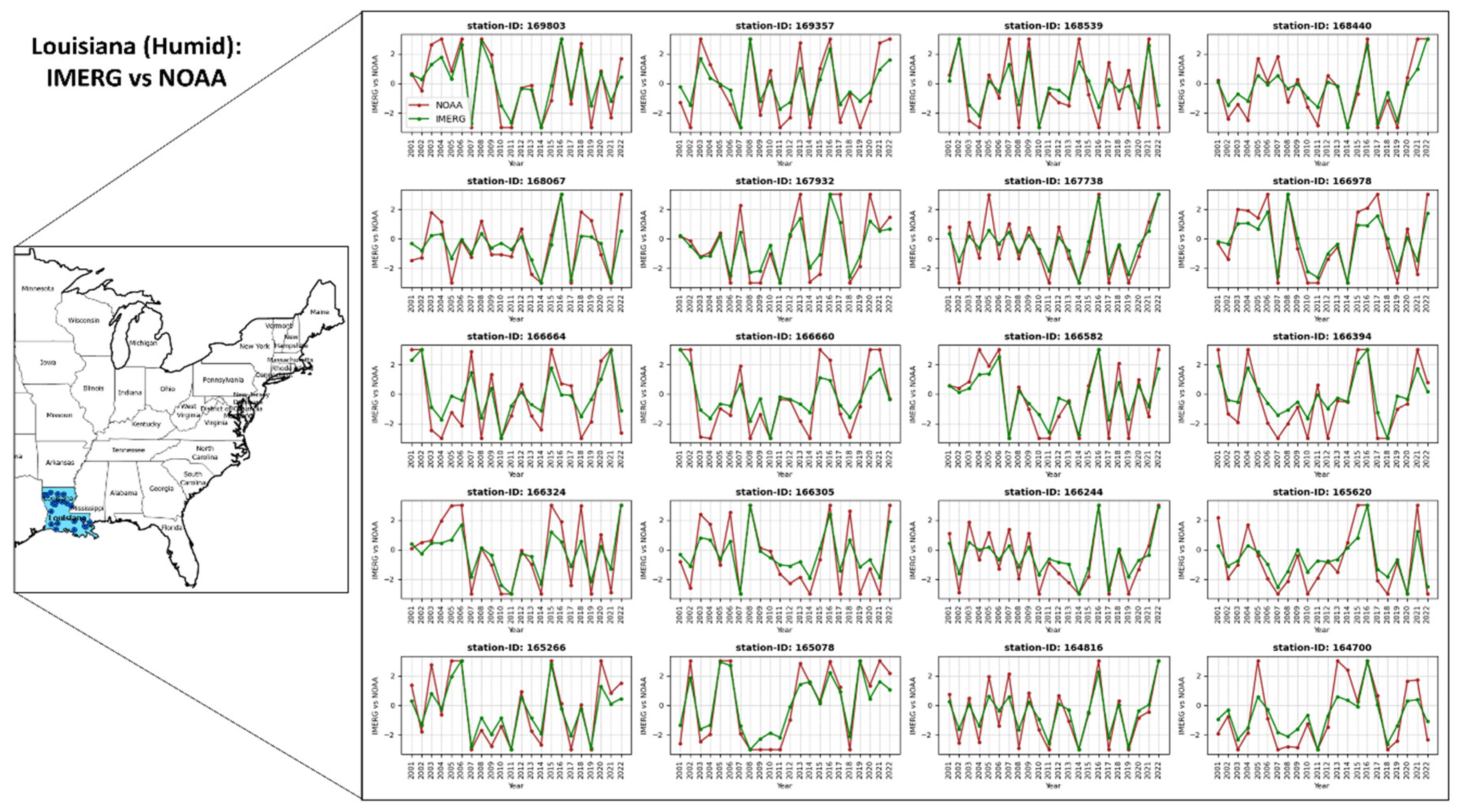
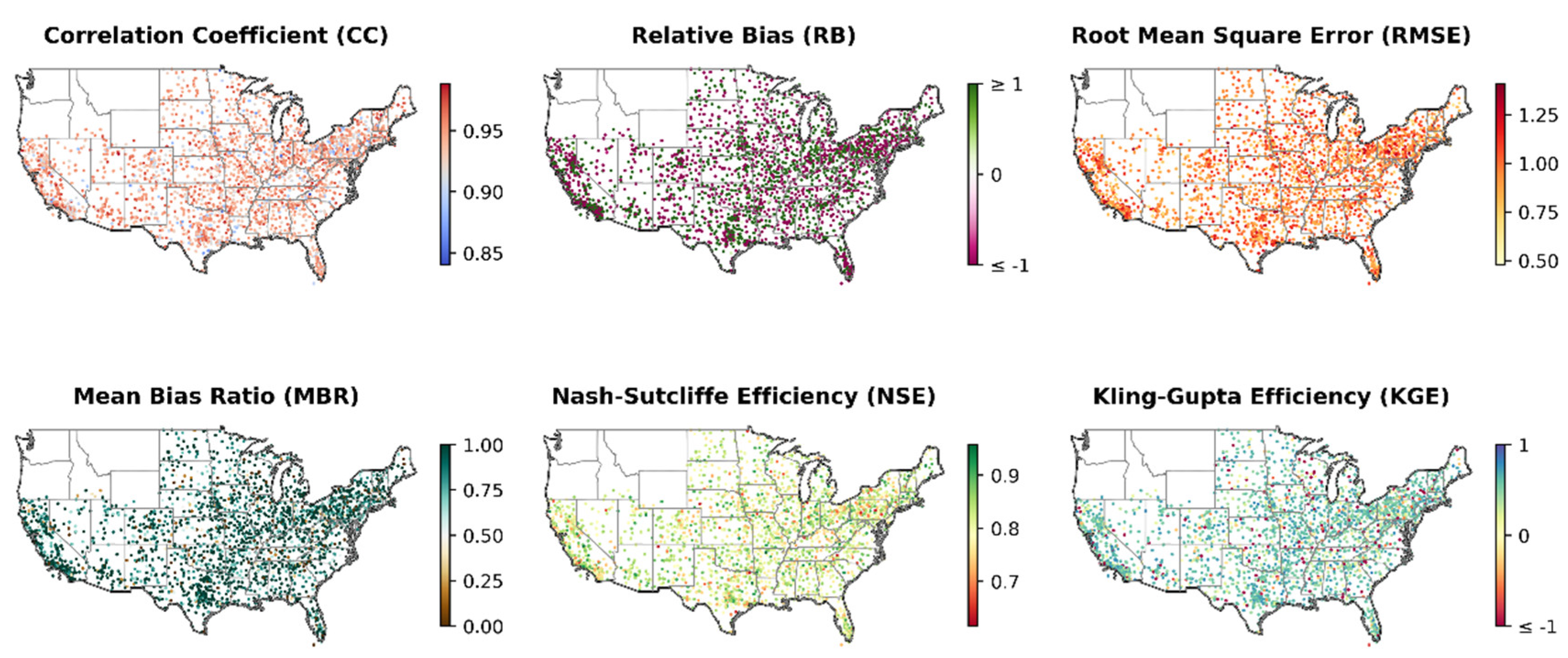
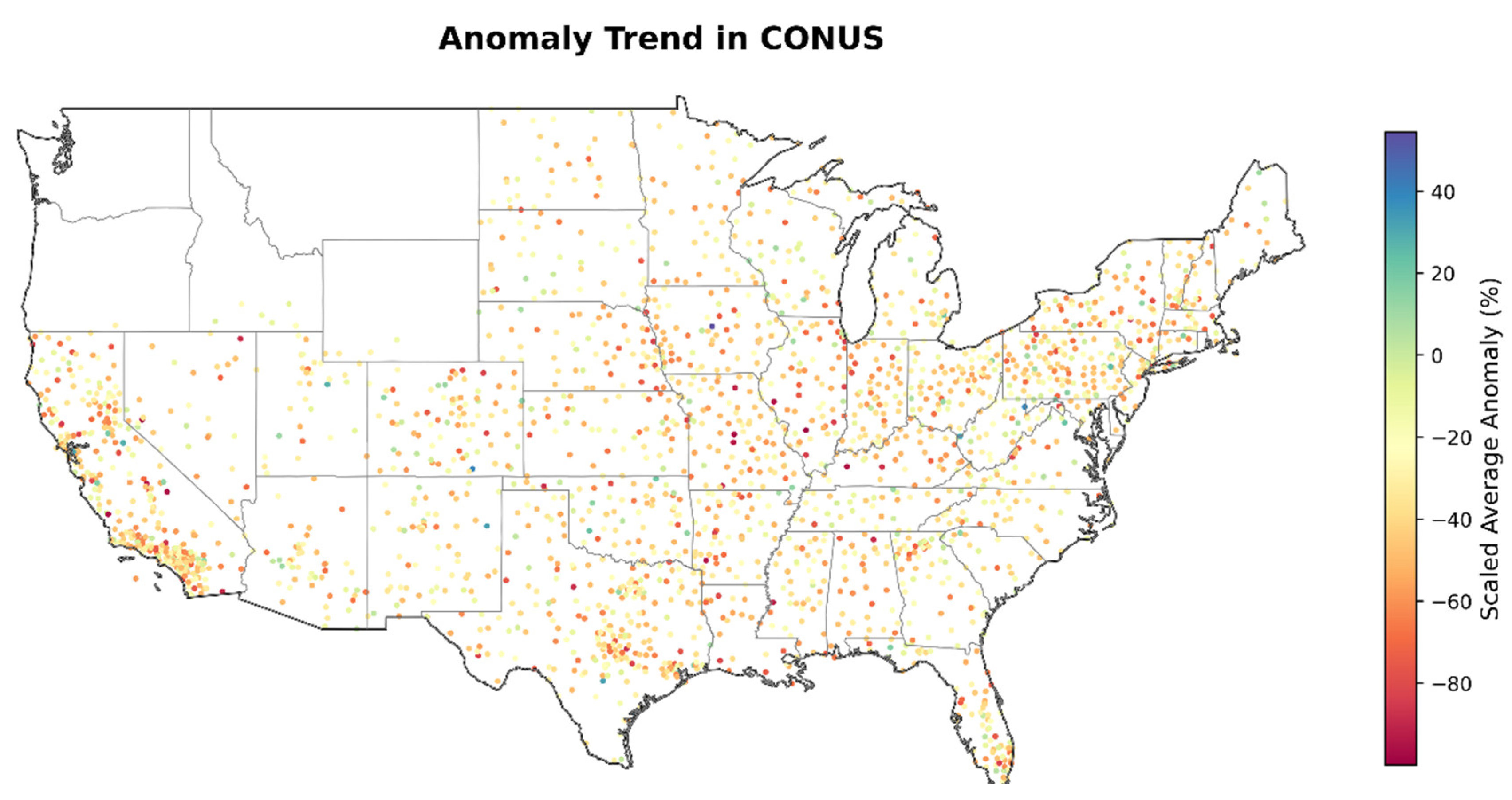
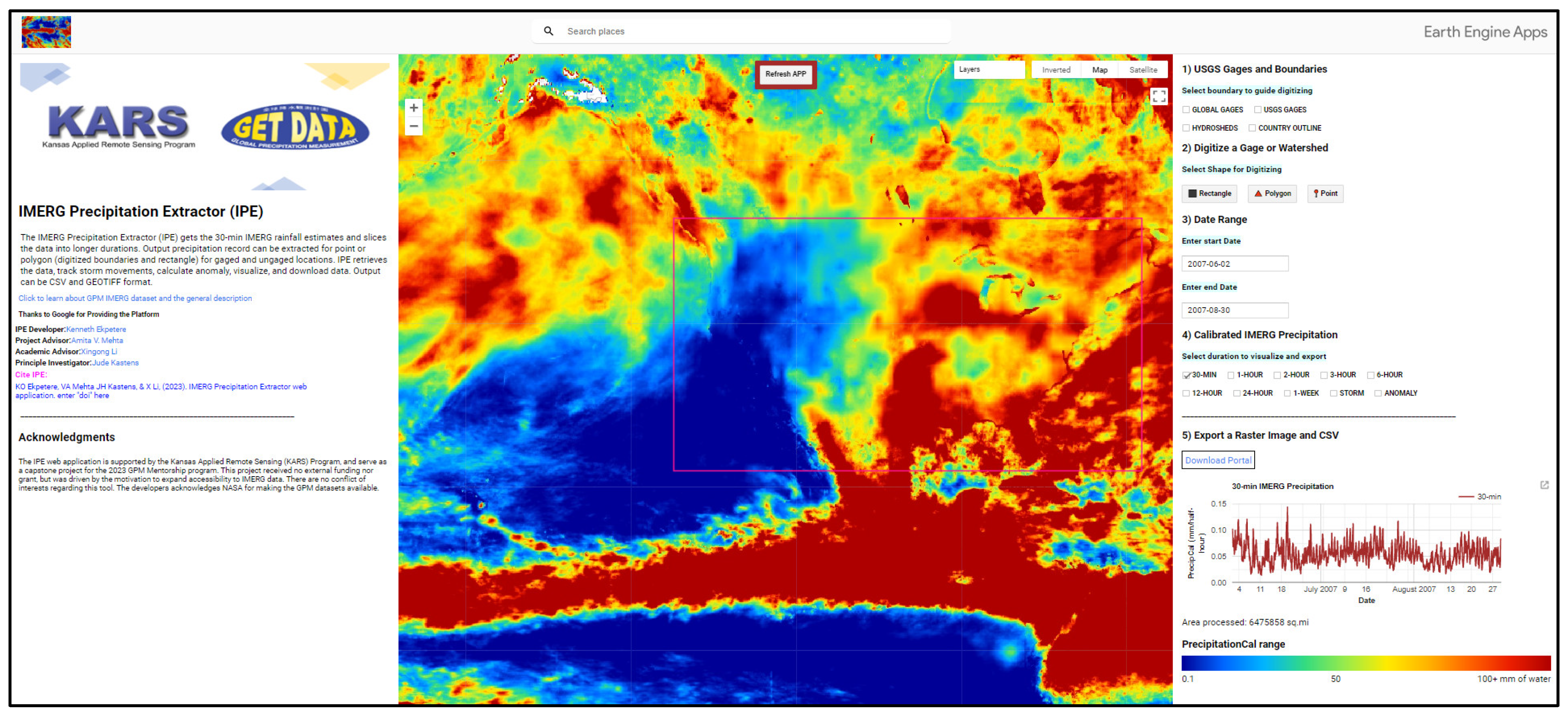
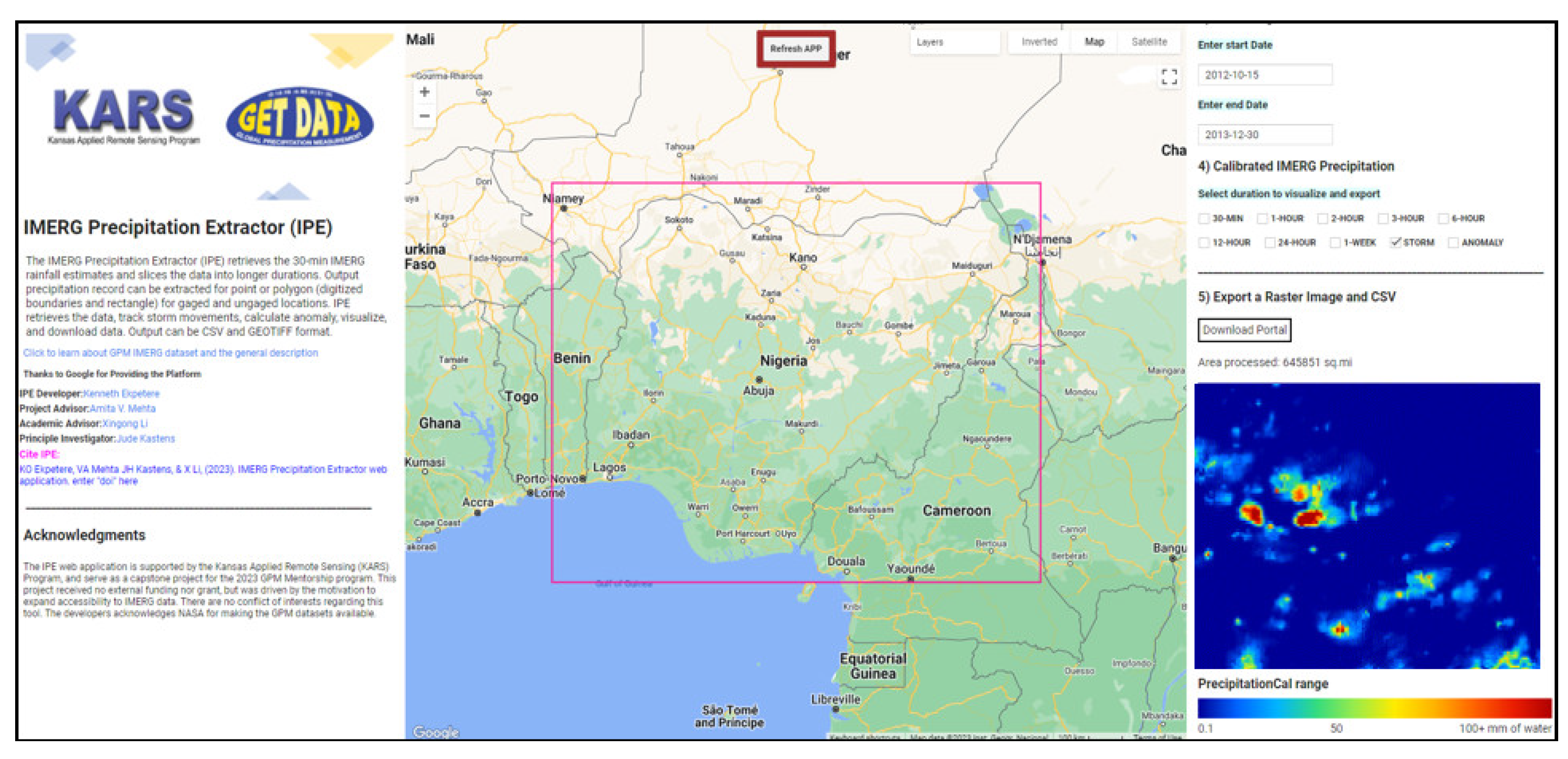
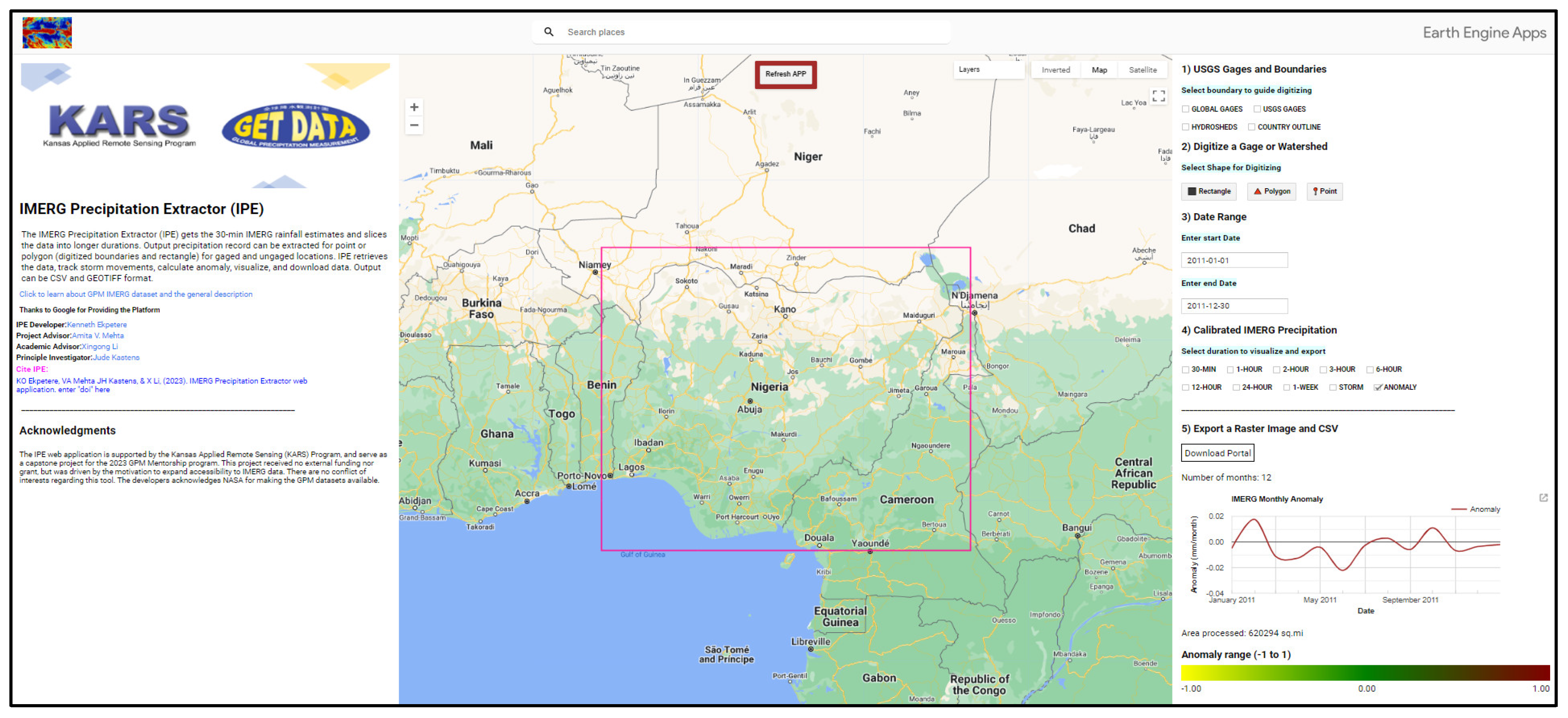
| Characteristics | NOAA station Data | IMERG Satellite Data |
| Spatial Resolution | ≥ 200 m (varies) | 0.1˚ (~11 km) |
| Temporal Resolution | 5-min to 60-days | Half-hourly |
| Period | 2001 – 2022 | 2001 – 2022 |
| Sensor(s) | Rain gages | GMI & DPR |
| Area coverage | CONUS | Global |
| Calibration | Gage | TRMM, TMPA, & GPCC |
| Ownership | NOAA | NASA & JAXA |
| Reference | [20] | (Huffman et al., 2020) |
| RAI | Class description |
| ≥ 3.00 | Extremely wet |
| 2.00 to 2.99 | Very wet |
| 1.00 to 1.99 | Moderately wet |
| 0.50 to 0.99 | Slightly wet |
| -0.49 to 0.49 | Near normal |
| -0.99 to -0.50 | Slightly dry |
| -1.99 to -1.00 | Moderately dry |
| -2.99 to -2.00 | Very dry |
| ≤ -3.00 | Extremely dry |
| Statistics | Formula | Range | Optimal Value | Unit |
|---|---|---|---|---|
| Correlation Coefficient (CC) | -1 to 1 | 1 | Unitless | |
| Percentage Relative Bias (PRB) | -∞ to +∞ | 0 | % | |
| Root Mean Square Error (RMSE) | 0 to +∞ | 0 | Unitless | |
| Mean Bias Ratio (MBR) | 0 to 1 | 1 | Unitless | |
| Nash-Sutcliffe Efficiency(NSE) | 0 to 1 | 1 | Unitless | |
| Kling-Gupta Efficiency(KGE) | -∞ to 1 | 1 | Unitless |
| Year | CC | PRB (%) | RMSE | MBR | NSE | KGE |
|---|---|---|---|---|---|---|
| 2001 | 0.93 | -15.29 | 0.94 | 0.85 | 0.79 | 0.63 |
| 2002 | 0.94 | -17.09 | 0.92 | 0.83 | 0.81 | 0.63 |
| 2003 | 0.94 | -4.40 | 1.00 | 0.96 | 0.78 | 0.62 |
| 2004 | 0.92 | -46.61 | 1.07 | 0.53 | 0.77 | 0.42 |
| 2005 | 0.94 | -67.37 | 0.92 | 0.33 | 0.85 | 0.28 |
| 2006 | 0.93 | -23.30 | 0.93 | 0.77 | 0.79 | 0.58 |
| 2007 | 0.94 | -14.19 | 0.97 | 0.86 | 0.81 | 0.65 |
| 2008 | 0.93 | -77.50 | 1.01 | 0.23 | 0.79 | 0.16 |
| 2009 | 0.93 | -15.90 | 0.95 | 0.84 | 0.79 | 0.61 |
| 2010 | 0.93 | -84.24 | 1.01 | 0.16 | 0.79 | 0.09 |
| 2011 | 0.94 | -12.18 | 0.98 | 0.88 | 0.80 | 0.64 |
| 2012 | 0.94 | -14.30 | 0.88 | 0.86 | 0.84 | 0.70 |
| 2013 | 0.94 | -17.97 | 0.94 | 0.82 | 0.82 | 0.63 |
| 2014 | 0.94 | -15.18 | 0.93 | 0.85 | 0.81 | 0.64 |
| 2015 | 0.94 | 9.06 | 0.97 | 1.00 | 0.83 | 0.69 |
| 2016 | 0.94 | -4.16 | 0.96 | 0.96 | 0.81 | 0.67 |
| 2017 | 0.94 | -2.67 | 0.97 | 0.97 | 0.81 | 0.67 |
| 2018 | 0.94 | 1.05 | 0.98 | 1.00 | 0.77 | 0.60 |
| 2019 | 0.93 | -15.13 | 0.93 | 0.85 | 0.79 | 0.61 |
| 2020 | 0.94 | 62.83 | 1.00 | 1.00 | 0.80 | 0.29 |
| 2021 | 0.93 | -85.50 | 1.01 | 0.15 | 0.80 | 0.08 |
| 2022 | 0.94 | -30.92 | 0.92 | 0.69 | 0.86 | 0.64 |
| Min | 0.92 | -85.50 | 0.88 | 0.15 | 0.77 | 0.08 |
| Max | 0.94 | 62.83 | 1.07 | 1.00 | 0.86 | 0.70 |
| Std. Dev | 0.00 | 33.70 | 0.04 | 0.28 | 0.02 | 0.20 |
| Mean | 0.94 | -22.32 | 0.96 | 0.74 | 0.80 | 0.52 |
| ID | Lat | Lon | CC | PRB | RMSE | MBR | NSE | KGE |
|---|---|---|---|---|---|---|---|---|
| 269234 | 40.4344 | -95.3883 | 0.95 | 41.29 | 0.91 | 1.00 | 0.84 | 0.50 |
| 269171 | 40.0825 | -93.6086 | 0.96 | 83.92 | 0.84 | 1.00 | 0.88 | 0.12 |
| 268988 | 37.2333 | -91.8833 | 0.95 | 273.52 | 1.12 | 1.00 | 0.78 | -1.76 |
| 268977 | 38.9483 | -94.3969 | 0.93 | -124.83 | 1.02 | 0.00 | 0.78 | -0.30 |
| 268838 | 37.7119 | -91.1328 | 0.96 | 13.50 | 0.77 | 1.00 | 0.90 | 0.74 |
| 268822 | 38.2017 | -91.9811 | 0.96 | 37.02 | 0.94 | 1.00 | 0.84 | 0.50 |
| 268170 | 36.9231 | -90.2836 | 0.94 | -31.74 | 0.95 | 0.68 | 0.77 | 0.52 |
| 267908 | 38.5425 | -90.9719 | 0.92 | -10.15 | 1.10 | 0.90 | 0.77 | 0.63 |
| 267640 | 36.8581 | -92.5875 | 0.98 | 6.47 | 0.65 | 1.00 | 0.92 | 0.77 |
| 267620 | 38.8128 | -90.8561 | 0.95 | -46.70 | 0.89 | 0.53 | 0.84 | 0.45 |
| 267612 | 36.7425 | -91.8347 | 0.95 | 183.83 | 0.83 | 1.00 | 0.86 | -0.86 |
| 267397 | 42.5522 | -99.8556 | 0.94 | 38.71 | 0.98 | 1.00 | 0.80 | 0.48 |
| 267369 | 42.2342 | -98.9156 | 0.96 | -39.67 | 0.89 | 0.60 | 0.85 | 0.50 |
| 266630 | 41.5975 | -99.8258 | 0.93 | -41.01 | 1.03 | 0.59 | 0.77 | 0.44 |
| 265880 | 42.0686 | -102.584 | 0.95 | 56.82 | 0.93 | 1.00 | 0.83 | 0.35 |
| 265869 | 41.2481 | -98.7989 | 0.97 | -22.74 | 0.75 | 0.77 | 0.90 | 0.67 |
| 265441 | 42.5800 | -99.54 | 0.96 | -28.89 | 0.92 | 0.71 | 0.84 | 0.57 |
| 265362 | 40.2994 | -96.75 | 0.95 | 3.95 | 0.94 | 1.00 | 0.82 | 0.66 |
| 265191 | 41.3686 | -96.095 | 0.98 | 64.55 | 0.59 | 1.00 | 0.94 | 0.33 |
| 264651 | 41.0469 | -102.147 | 0.94 | -43.67 | 1.11 | 0.56 | 0.76 | 0.40 |
| Min | 0.92 | -124.83 | 0.59 | 0.00 | 0.76 | -1.76 | ||
| Max | 0.98 | 273.52 | 1.12 | 1.00 | 0.94 | 0.77 | ||
| Std. Dev | 0.02 | 87.26 | 0.14 | 0.26 | 0.05 | 0.61 | ||
| Mean | 0.95 | 20.71 | 0.91 | 0.82 | 0.83 | 0.29 | ||
| ID | Lat | Lon | CC | PRB | RMSE | MBR | NSE | KGE |
|---|---|---|---|---|---|---|---|---|
| 169803 | 41.0333 | -81.0167 | 0.95 | 9.90 | 0.80 | 1.00 | 0.88 | 0.74 |
| 169357 | 41.4619 | -84.5272 | 0.94 | -37.68 | 1.09 | 0.62 | 0.78 | 0.47 |
| 168539 | 41.4667 | -81.1667 | 0.94 | -49.55 | 1.03 | 0.50 | 0.80 | 0.40 |
| 168440 | 40.0167 | -81.5833 | 0.93 | -11.48 | 0.81 | 0.89 | 0.83 | 0.70 |
| 168067 | 40.7667 | -81.3833 | 0.87 | 24.54 | 0.99 | 1.00 | 0.72 | 0.57 |
| 167932 | 40.3000 | -82.65 | 0.94 | 32.04 | 0.92 | 1.00 | 0.82 | 0.55 |
| 167738 | 40.7400 | -82.3569 | 0.93 | -16.59 | 0.83 | 0.83 | 0.82 | 0.68 |
| 166978 | 39.3744 | -83.0036 | 0.96 | 422.46 | 0.82 | 1.00 | 0.87 | -3.23 |
| 166664 | 38.7983 | -84.1731 | 0.93 | -90.27 | 1.11 | 0.10 | 0.77 | 0.03 |
| 166660 | 41.0517 | -81.9361 | 0.93 | -40.84 | 1.13 | 0.59 | 0.76 | 0.43 |
| 166582 | 39.1000 | -84.5167 | 0.95 | 5.43 | 0.84 | 1.00 | 0.85 | 0.71 |
| 166394 | 39.6106 | -82.9547 | 0.94 | -80.95 | 1.04 | 0.19 | 0.77 | 0.11 |
| 166324 | 41.4050 | -81.8528 | 0.92 | 354.06 | 1.16 | 1.00 | 0.74 | -2.56 |
| 166305 | 40.8833 | -80.6833 | 0.92 | -36.52 | 1.12 | 0.63 | 0.75 | 0.47 |
| 166244 | 39.9914 | -82.8808 | 0.93 | -28.00 | 0.83 | 0.72 | 0.82 | 0.61 |
| 165620 | 41.9833 | -80.5667 | 0.91 | -13.79 | 1.02 | 0.86 | 0.75 | 0.61 |
| 165266 | 39.9061 | -84.2186 | 0.95 | 55.69 | 0.83 | 1.00 | 0.86 | 0.39 |
| 165078 | 39.6253 | -83.2128 | 0.97 | 12.62 | 0.83 | 1.00 | 0.89 | 0.72 |
| 164816 | 41.2833 | -84.3833 | 0.94 | -17.11 | 0.77 | 0.83 | 0.84 | 0.68 |
| 164700 | 40.0000 | -82.0833 | 0.90 | 2.44 | 1.15 | 1.00 | 0.72 | 0.59 |
| Min | 0.87 | -90.27 | 0.77 | 0.10 | 0.72 | -3.23 | ||
| Max | 0.97 | 422.46 | 1.16 | 1.00 | 0.89 | 0.74 | ||
| Std. Dev | 0.02 | 129.73 | 0.14 | 0.27 | 0.05 | 1.08 | ||
| Mean | 0.93 | 24.82 | 0.96 | 0.79 | 0.80 | 0.18 | ||
Disclaimer/Publisher’s Note: The statements, opinions and data contained in all publications are solely those of the individual author(s) and contributor(s) and not of MDPI and/or the editor(s). MDPI and/or the editor(s) disclaim responsibility for any injury to people or property resulting from any ideas, methods, instructions or products referred to in the content. |
© 2024 by the authors. Licensee MDPI, Basel, Switzerland. This article is an open access article distributed under the terms and conditions of the Creative Commons Attribution (CC BY) license (http://creativecommons.org/licenses/by/4.0/).





